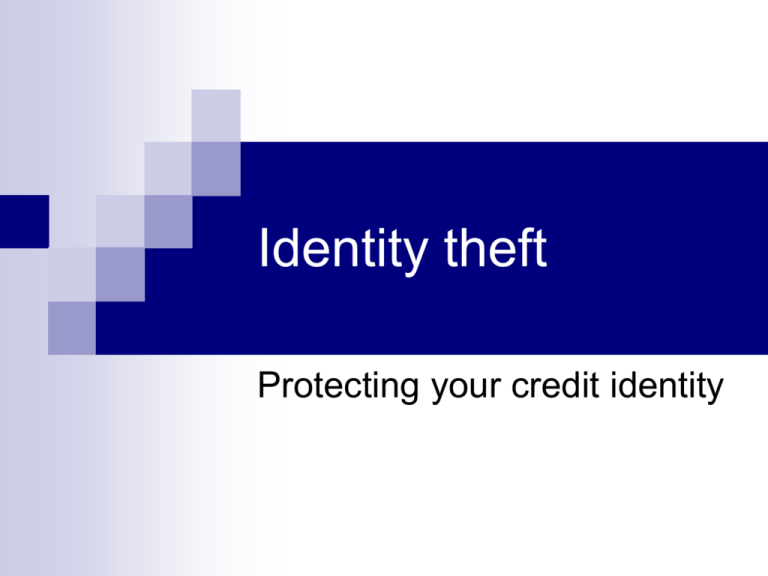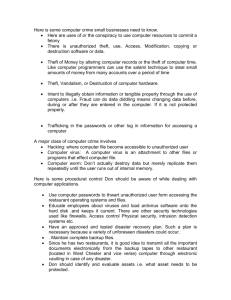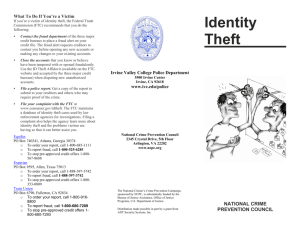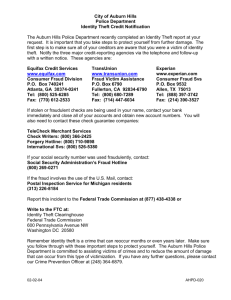Identity theft
advertisement

Identity theft Protecting your credit identity Identity Theft Three hundred forty three million was lost from consumers in 2002 The number of complaints filed in 2002 was 380,000—almost double from the 204,000 filed in 2001. Consumers spent 26 billion dollars on line in 2002. Identity Theft Identity theft occurs when someone wrongfully acquires and uses someone’s personal identification, credit or account information Personal Information Includes Name Address and telephone number Social Security Number Driver’s license number Bank Account numbers Credit Card numbers Passwords Bills Ways Identity Thieves Acquire Information Wallet/Purse Loss or theft Mail and Phones Dumpster diving Insider access Internet shopping Credit report How information can be used To get a new driver’s license Open a new bank account Apply for credit cards or open new store accounts Obtain cash from credit cards To get a job To rent an apartment To make retail purchases Credit reports How theft occurs Thief fraudulently orders a credit report Prevention Order credit reports each year Don’t leave credit reports laying around 3 Credit reporting agencies Equifax P.O. box 105873 Atlanta, GA 30348 Report order: 1-800-685-1111 Fraud Hotline: 1-800-525-6285 www.equifax.com Experian P.O. Box 2104 Allen, TX 75013-2104 Report Order: 1-888-397-3742 Fraud Hotline: 1-888-397-3745 www.experian.com Trans Union P.O. Box 390 Springfield, P.A. 19064-0390 Report Order: 1-800-888-4213 Fraud Hotline: 1-800-680-7289 www.tuc.com Mail How theft occurs Thief steals account numbers and personal information Prevention Deposit outgoing mail in mailbox Don’t leave mail in mailbox If on vacation, put mail on hold Wallets and Pocketbooks How it occurs Thief steals wallet or pocketbook Prevention Don’t put it in plain sight Don’t hang it on the back of the chair Use a purse that closes securely Carry only what is necessary Bills How theft occurs Bills contain personal information, account numbers May use information to start a new account Prevention Don’t leave bills laying around Pay attention to billing cycle Calling Cards How theft occurs If thief has calling card and id number, can make long distance calls anywhere Prevention Use only card that have an id number Protect from those who are watching over your shoulder Passwords How theft occurs Thief watches you or comes across your list Prevention Don’t give passwords to anyone Don’t write passwords down Use different passwords for each account Work records How theft occurs Thief may access work records, SS#, bank records Prevention Ensure work records are locked with security from employees or others Pre-approved credit cards How theft occurs Activate accounts from pre-approved cards Prevention Shred credit card offers Cut up pre-approved credit cards Bank Account Information How theft occurs With bank account routing number, thief can make checks, withdraw money, or access savings Prevention Don’t leave statements lying around Use passwords Don’t have checks mailed. Pick them up. Social Security Number How theft occurs This is the key to your identity Prevention Never give out social security number Don’t carry social security card Ask for alternate number ATM, Credit, Debit Cards How theft occurs Some locations ask for card and PIN number Credit and Debit cards are easy to use because most businesses don’t ask for additional ID Easy to use over internet and phone ATM, Credit, and Debit Cards Prevention Don’t leave cards laying around Only carry those cards you will use Use debit cards that require a PIN Write on back of card “Ask for ID” in signature blank Carry cards in separate holder Cards, cont. Have a list of account numbers and cards Don’t give out numbers unless you are making a purchase Keep track of all receipts Destroy papers with account numbers on it Check statements for fraudulent activity What to do if Identity Theft Happens Immediate steps 1. 2. 3. 4. 5. 6. Act immediately! Keep a detailed record of correspondence and phone records. Contact the three major credit bureaus and request a “fraud alert.” Follow with a letter sent by certified mail. Close all accounts which have been tampered with or opened fraudulently. File a police report. File a complaint with the Federal Trade Commission. Credit Card Liability Truth in Lending Act limits liability for unauthorized charges to $50.00 per card. A letter must be received within 60 days of the first bill containing the error. The dispute must be resolved within 90 days of the creditor receiving the letter. ATM, Debit, and Credit Cards The Electronic Funds Transfer Act limits your liability -Within 2 days, $50 -Within 60 days, $500 -After that you are responsible for whole amount To report a loss call the financial institution and follow up in writing Get new bank numbers, PIN, and passwords Check liability Contact the financial institution and stop payment. Notify the check verification service. Most states hold the financial institution responsible for losses of a forged check Stay Alert! Be Careful! Be Smart!




